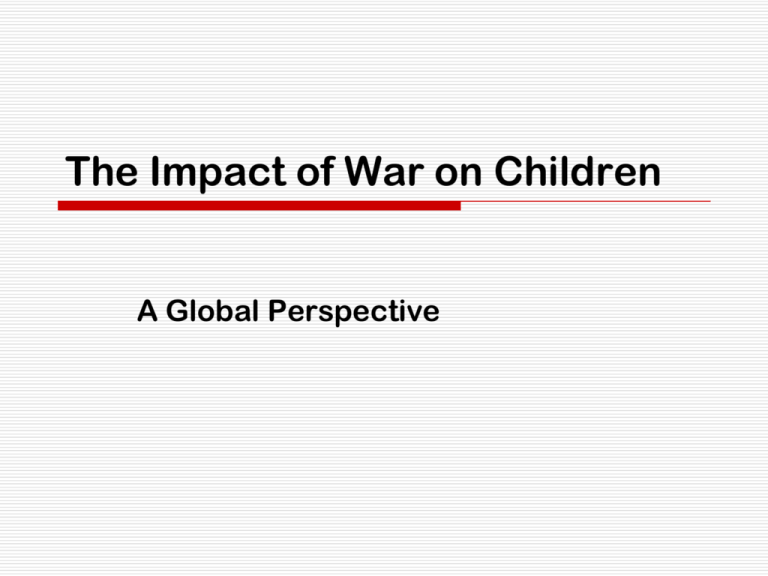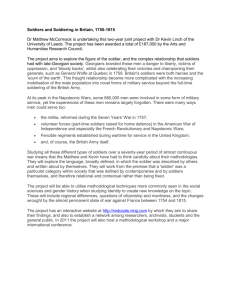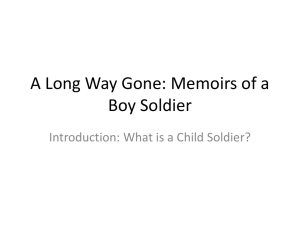Impact of War on Children - Public Health and Social Justice
advertisement

The Impact of War on Children A Global Perspective Basic Information Women and children account for almost 80% of the casualties of conflict and war They also account for 80% of the 40 million refugees worldwide In the last decade, approximately two million children have been killed in wars and conflicts 4.5 million children have been disabled and 12 million have been left homeless Ways in Which War Directly Impacts Children Death Injury Disability Illness Rape and prostitution Psychological suffering Moral and spiritual impacts Social and cultural losses Child soldiers Exploitation Separation of Families Unaccompanied children are likeliest to have their rights violated, be killed, tortured, raped, robbed and recruited as child soldiers. By the end of 1994, more than 100,000 Rwandan children had been separated from their families - the highest number of such children registered by UNICEF since the agency was founded in 1946. In Cambodia, half the population is under the age of 15. The disintegration of the Cambodian family has led to increased rates of delinquency, crime, drug abuse and child prostitution. Separation of Families Adolescent girls often assume responsibility for their younger siblings. In September 1995, UNICEF and the Rwandan Government identified 1,939 children living in child-headed households. Child-headed households are also vulnerable to exploitation by surviving relatives and neighbors. In Cambodia some refugee families had temporarily adopted unaccompanied children in order to obtain additional food and relief supplies, only to abandon the children once they returned to Cambodia. Separation of Families In Bosnia and Herzegovina, some evacuations of children had been organized by groups intent on profiting from adoption markets. Many unaccompanied displaced children are not orphans and greater emphasis needs to be placed on reuniting families – especially before allowing any type of permanent adoption procedure to take place. What Can Be Done Reunification programs should be a main priority in all new and existing relief operations. Refugee camps should be located far from conflict zones to reduce the risk of children being enticed or recruited into warring groups. They should have food/water sources in locations that can be easily monitored to prevent further victimization. In Sudanese refugee camps in Ethiopia: 'villages' have been created with three to five children living together in each traditional hut under the supervision of a caregiver from among their own people. Child Soldiers According to a 1996 Unicef report, there are approximately 300,000 child soldiers, including many girls who are forced to 'service' the troops. Young girls are also used as combatants but at a much lesser rate than their male counterparts. Children are more easily armed and require less training. Current weapons are lightweight and easy to fire. Children also tend to be more obedient and usually do not demand pay for their services. Child Soldiers - Recruitment In Liberia, children as young as seven have been found in combat. In Cambodia, a survey of wounded soldiers found that 20 per cent of them were between the ages of 10 and 14 when recruited. In Sri Lanka, of 180 Tamil Tiger guerrillas killed in one government attack, more than half were still in their teens, and 128 were girls. In the Sudan, children as young as 12 have been rounded up from buses and cars. Child Soldiers - Recruitment In Guatemala, youngsters have been grabbed from streets, homes, parties, and even violently removed from churches. In the 1980s, the Ethiopian military recruited boys, sometimes at gunpoint, from football fields, markets, religious festivals or on the way to school. Child Soldiers - Successes In Peru, for example, forced recruitment drives reportedly declined in areas where they were denounced by parish churches. In Myanmar, protests from aid agencies led to the release of boys forcibly recruited from a refugee camp. In Sudan, humanitarian organizations negotiated agreements with opposition groups to prevent the recruitment of children. References Somasundaram, Daya “Short and Long-Term Effects on the Victims of Terror in Sri Lanka.” Journal of Aggression, Maltreatment & Trauma 9.1,9.2 (2004): 215-228. Modell, J & Haggerty, T “The Social Impact of War.” Annual Review of Sociology 17 (1991): 205-224. Levy,B. S. and Sidel, V.W “The Social Impact of War.” Annual Review of Public Health 30 (2009): 3.1-3.14. References Toole, M. J. & Waldman, R. J. “The Public Health Aspects of Complex Emergencies and Refugee Situations.” Annual Review of Public Health 18 (1991): 283-312. Levy,B.S. and Sidel, V.W “The Social Impact of War.” Annual Review of Sociology 17 (1991): 205-224. Marshall, Lucinda. “Unacceptable: The Impact of War on Women and Children.” Common Dreams News Center. 2004. 2 Dec. 2008 <http://www.commondreams.org/views04/1219-26.htm>. References Machel, Graca. “Promotion and Protection of the Rights of Children.” UNICEF. 1996. 24 Nov. 2008 <http://www.unicef.org/graca/a51-306_en.pdf>. Barbara, Joanna S. “Impact of War on Children and Imperative to End War.” Croatian Medical Journal. 2006. 24 Nov. 2008 <http://www.pubmedcentral.nih.gov/articlerender.fcgi?artid=2080 482>. Hamblem, Jessica “PTSD in Children and Adolescents.” National Center for Posttraumatic Stress Disorder. 1998. 2 Dec. 2008 <http://www.ncptsd.va.gov/ncmain/ncdocs/fact_shts/fs_children.h tml>.






